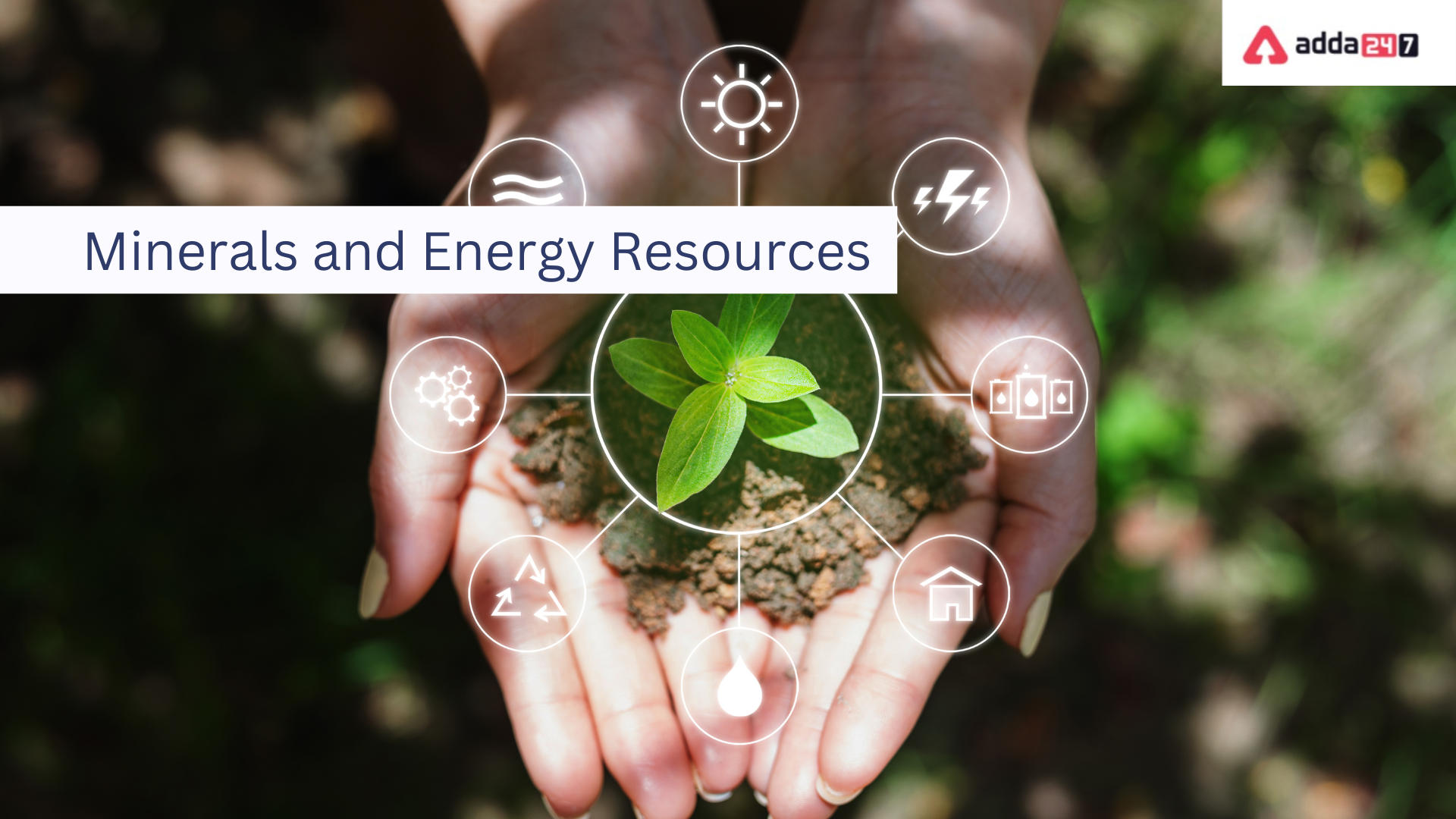Table of Contents
Minerals and Energy Resources Class 10- What is a Mineral?
Mineral is defined as a “homogenous, naturally occurring substance with a definable internal structure.” Minerals are found in varied forms in nature, ranging from the hardest diamond to the softest talc. Rocks are combinations of homogeneous substances called minerals.Minerals are also classified into energy resources. There are various sources of energy such as coal, petroleum, natural gas, etc., which are non-renewable resources, and other sources of energy are solar energy, wind energy, etc.
Minerals and Energy Resources- Mode of Occurrence of Minerals
Minerals are usually found in “ores”. The term ore is used to describe an accumulation of any mineral mixed with other elements.
Minerals generally occur in the following forms:
- In igneous and metamorphic rocks, minerals may occur in the cracks, crevices, faults or joints.
- In sedimentary rocks, a number of minerals occur in beds or layers.
- The decomposition of surface rocks and the removal of soluble constituents also forms the minerals.
- Minerals also occur as alluvial deposits in sands of valley floors and the base of hills.
- The ocean waters contain vast quantities of minerals.
Class 10 students can now join the board exam preparation batch by Adda247 and ace their board exam.
Minerals and Energy Resources- Classification of Minerals
The major iron ore belts in India are:
- Odisha-Jharkhand belt
- Durg-Bastar-Chandrapur belt
- Ballari-Chitradurga-Chikkamagaluru-Tumakuru belt
- Maharashtra-Goa belt
Ferrous Minerals
Ferrous minerals account for about three-fourths of the total value of the production of metallic minerals.
Iron Ore
- India is endowed with fairly abundant resources of iron ore.
- Magnetite is the finest iron ore with a very high content of iron, up to 70%. It has excellent magnetic qualities.
- Hematite ore is the most important industrial iron ore. It contains 50 to 60% iron.
Manganese
It is mainly used in the manufacturing of steel and ferro-manganese alloy.
- Nearly 10 kg of manganese is required to manufacture 1 tonne of steel.
- It is also used in manufacturing bleaching powder, insecticides and paints.
- Non-Ferrous Minerals
- Non-ferrous minerals include copper, bauxite, lead, zinc and gold. These minerals play a vital role in a number of metallurgical, engineering and electrical industries.
Copper
- Malleable, ductile and good conductor of heat and electricity.
- Mainly used in electrical cables, electronics and chemical industries.
- The Balaghat mines in Madhya Pradesh, Khetri mines in Rajasthan and Singhbhum district of Jharkhand are leading producers of copper.
Bauxite
- Bauxite deposits are formed by the decomposition of a wide variety of rocks rich in aluminium silicates.
- Aluminium is obtained from bauxite. Aluminium has good conductivity and great malleability.
- Deposits are mainly found in the Amarkantak plateau, Maikal hills and the plateau region of Bilaspur-Katni.
Non-Metallic Minerals
- Mica is the most indispensable mineral used in the electric and electronic industries.
- It has excellent di-electric strength, low power loss factor, insulating properties and resistance to high voltage.
- Mica deposits are found in the northern edge of the Chota Nagpur plateau.
Rock Minerals
- Limestone is found in rocks composed of calcium carbonates or calcium and magnesium carbonates.
- It is the basic raw material for the cement industry and essential for smelting iron ore in the blast furnace.
Conservation of Minerals
Energy resources can be classified as
Conventional Sources: It includes firewood, cattle dung cake, coal, petroleum, natural gas and electricity.
Non-Conventional Sources: It includes solar, wind, tidal, geothermal, biogas and atomic energy
Let us discuss each of them in detail.
Minerals and Energy Resources- Non-Conventional Sources of Energy
Coal:
It is the most abundantly available fossil fuel.
It is used for power generation, to supply energy to the industry as well as for domestic needs.
Lignite is a low grade brown coal, which is soft with high moisture content.
Coal that has been buried deep and subjected to increased temperatures is bituminous coal.
Anthracite is the highest quality of hard coal.
Jharia, Raniganj, Bokaro are important coalfields.
Petroleum
It provides fuel for heat and lighting, lubricants for machinery and raw materials for a number of manufacturing industries.
Petroleum refineries act as a “nodal industry” for synthetic textile, fertiliser and numerous chemical industries.
Mumbai High, Gujarat and Assam are major petroleum production areas in India.
Natural Gas
Natural gas is an important clean energy resource. It is considered an environment-friendly fuel.
The power and fertilizer industries are the key users of natural gas.
Compressed Natural Gas (CNG ) is used in vehicles to replace liquid fuels.
Large reserves of natural gas have been discovered in the Krishna-Godavari basin
Electricity
Electricity is generated mainly in 2 ways:
By running water which drives hydro turbines to generate Hydro Electricity. It is a renewable resource of energy. India has a number of multi-purpose projects like the Bhakra Nangal, Damodar Valley Corporation, the Kopili Hydel Project.
By burning other fuels such as coal, petroleum and natural gas to drive turbines to produce Thermal Power. It uses non-renewable fossil fuels for generating electricity.
Non-Conventional Sources of Energy
The renewable energy sources like solar energy, wind, tide, biomass and energy from waste material are called Non-Conventional Energy Sources. Let’s discuss them one by one.
Nuclear or Atomic Energy
Nuclear Energy is obtained by altering the structure of atoms. Uranium and Thorium are used for generating atomic or nuclear power.
Solar Energy
Solar energy is produced by the Sun’s light. Photovoltaic technology converts sunlight directly into electricity.
Wind Power
Wind Energy or Power is the use of wind to generate electricity. Wind turbines are used for this purpose. The largest wind farm cluster is located in Tamil Nadu from Nagarcoil to Madurai.
Biogas
Biogas is a type of biofuel that is naturally produced from the decomposition of organic waste. Biogas is the most efficient use of cattle dung. It improves the quality of manure.
Tidal Energy
Tidal energy is the form of hydropower that converts the energy obtained from tides into useful forms of power, mainly electricity. In India, the Gulf of Khambhat, the Gulf of Kachchh in Gujarat on the western coast and Gangetic delta in Sunderban regions of West Bengal provide ideal conditions for utilising tidal energy.
Geo-Thermal Energy
When heat and electricity are produced by using the heat from the interior of the earth, it is known as Geo-Thermal Energy. In India, geothermal energy is harnessed from Parvati valley near Manikarn in Himachal Pradesh and from Puga Valley, Ladakh.
Minerals and Energy Resources- Conservation of Energy Resources
Every sector of the national economy – agriculture, industry, transport, commercial and domestic – needs inputs of energy. There is an urgent need to develop a sustainable path for energy development. Here are some ways that each one of us can contribute to save energy resources:
- Using public transport systems instead of individual vehicles
- Switching off electricity when not in use
- Using power-saving devices.
- Using non-conventional sources of energy
Found this article helpful?
Let’s connect via chat or call our senior expert counsellor at +91-9625869989 to learn more about the different streams and options available.
We would love it if we could add some of your insights. If you have a definite goal of scoring the highest marks, then you can resolve your doubts via our app/quizzes and youtube class assistance (https://www.youtube.com/c/Adda247School)
Minerals and Energy Resources Class 10 Notes- FAQs
Question 1 What are the advantages of ‘mineral resources’?
Ans. Minerals are non–renewable natural resources that are vital for the construction, manufacturing and energy industries.
Question 2 What are the major minerals found in India?
Ans. India’s major mineral resources include Coal, Iron ore, Manganese ore , Mica and Bauxite.
Question 3 What are the uses of ‘Tidal energy’?
Ans. 1. Consistency 2. Long term economy 3. Intermittence 4. Startup costs 5. Permanence
Question 4 What are the 4 main types of mineral resources?
Ans. Mineral resources can be divided into two major categories – Metallic and Nonmetallic. Metallic resources are things like Gold, Silver, Tin, Copper, Lead, Zinc, Iron, Nickel, Chromium, and Aluminum. Nonmetallic resources are things like sand, gravel, gypsum, halite, Uranium, dimension stone.
Question 5 What are 10 uses of minerals?
Ans. Uses of Metallic Minerals
- Aluminium: Aluminium is the most abundant metallic mineral in the earth’s crust. It is extracted from bauxite ore. …
- Automobile industry.
- Building industry.
- Electrical industry.
- Manufacture of cans, bottles etc.
- Copper: It is another important metallic mineral that has a wide range of uses.
Question 6 How do we use minerals?
Ans. While minerals are frequently used to create the materials used in the construction of roads and buildings, they also serve as critical components in the manufacturing of high-tech electronics, next-generation vehicles and other everyday devices.


 MP Board 5th Class Result 2024 Out, Chec...
MP Board 5th Class Result 2024 Out, Chec...
 MP Board 8th Class Topper List 2024 Out,...
MP Board 8th Class Topper List 2024 Out,...
 TS Inter Results 2024- Manabadi 1st, 2nd...
TS Inter Results 2024- Manabadi 1st, 2nd...














